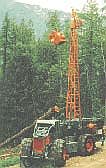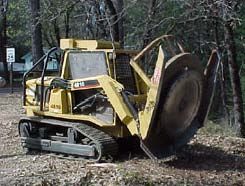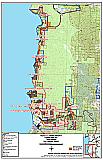11.0 Recommended Hazard Mitigation Projects
11.1 Hazard Mitigation Treatments
Effective wildfire mitigation measures involve the reduction or removal of fuels, or vegetation. A number of methods, both traditional and new, are available to modify the vegetation structure on the landscape. A few key techniques are described below as they occur throughout the project recommendation sheets. The successful mitigation of wildfire hazards in the Lake Tahoe Basin will likely include a combination of treatment methods, as no single method alone is the solution.
11.1.1 Prescribed fire
Fire is part of the natural condition, as described in Section 3.4. Current and historic activities have removed fire from the ecosystem. Uncontrolled fires in residential communities can be tragic. However a prescribed fire under controlled conditions can be used as an effective treatment method to reduce fuel loadings in the forest environment.
The current fuel loads are higher than what would occur under natural conditions and are too high to safely use fire as a management tool. Pre-treatment would be required to remove excessive vegetative material prior to burning.
Implementing prescribed fire is a complicated process. Treatment areas are subject to the same environmental compliance measures as other types of treatment. Containment measures must be taken so that fire burns in a controlled and prescribed manner. Fire control lines must be constructed around the perimeter of the area to be burned, and extra suppression resources available must be made available during the burning operation. In addition, a contingency plan should be developed prior to burning to account for all possible emergencies.
Burning must be limited so acceptable levels of air quality are not exceeded. For air quality and fire control, the burning season is relatively short, and unpredictable, each year, occurring usually just before or just after winter. At this time of the year, temperatures and moisture are at levels to allow enough burning to effectively consume fuels, but not allow the fire to spread out of control.
The North Lake Tahoe Fire Protection District developed a Prescribed Burn Plan (August 2003), addressing most of these issues. It should be used as a model to develop future planning efforts in both Nevada fire districts. The plan should be reviewed annually to update projects completed the previous year and validate the environmental compliance and contingency resources available for operations.
The most important element of a prescribed fire treatment project is the public education component. For almost 100 years, federal agencies and the fire service have convinced the public that fire is the enemy and must be excluded from the wildland. Public education messages are already changing, however, it is important to stress the prescribed fire management tool to neighbors before implementing it in their backyard.
11.1.2 Yarding Systems

The biggest challenge to implementing treatments that require the removal of fuels, particularly trees, is transportation from the forest to a landing, or staging area. TRPA BMPs restrict the ability to disturb soils and in many cases the topography precludes use of traditional mechanical equipment such as skidders, loaders, and forwarders. Helicopters have been used in the past to remove trees from the forest without dragging them on the ground. Another alternative is aerial yarding systems.
Cable yarding is a traditional transport method for timber harvests. Suited for working on steep slopes, yarding is a system of cables and pulleys that can transport material thousands of feet to a central landing. Typically a long cable line is stretched into the forest, on which sits a carriage that moves up and down the line. The carriage has cables that reach to the ground. Logs, slash, or brush can be attached to the cables, and the carriage can move the material up or downhill depending on the equipment and cable configuration. Aerial yarding systems allow for the material to be lifted from the ground before being transported to a landing. This reduces the amount of soil disturbance in biomass removal operations
These systems take some time to setup, however experienced crews should be able to complete setups in these districts within two hours. With various carriage configurations, cables can reach a few hundred feet from the mainline, allowing a large area to be treated from a single skyline. Though they require more human labor than a helicopter logging operation, the yarding systems may be more costs effective over time. Initially yarding may be more expensive than hand-cut, pile, and burning. The ability to transport material out of an area and bring rehabilitation materials in to an area will be critical to the long-term success of land management objectives. The fire districts, TRPA, and the Forest Service should seek to immediately establish demonstration projects using this type of technology to help both short and long-term costs associated with its use.
11.1.3 Mastication

Mastication results in changing the structure of the fuel bed but leaving the material out in the treatment area. Like a big mulching lawnmower, masticators have large cutting heads mounted on a tractor to break up stands of tall brush and small trees. The biomass material is reduced to a layer of chips and sticks on the ground. Though it will still burn, flame lengths from a few inches of chipped material are much more controllable than flame lengths from brush that is eight feet tall. The objective is not to remove the fuels but to change the structure of the fuel bed.
Mastication is a mechanical treatment, so the slopes on which tractor type equipment can function limit its use. Tractors typically have a low impact on soil disturbance as they are mounted either on a track excavator undercarriage, or on a low pressure three or four rubber tire carriage. Cutting heads can be raised and lowered or articulated on the end of an excavator. A trailer can be pulled behind a masticator to haul the chips from an area.
11.1.4 Hand Cut, Pile, and Burn
Hand cut, pile, and burn is currently the most economical fuel reduction method allowed on slopes greater than 30 percent in the Tahoe Basin. Helicopter logging has been used but is extremely expensive, currently requiring roughly $7,000 per hour and while cable yarding has been proposed, the TRPA has not accepted this method of biomass removal. Using the hand cut method, chainsaws or axes are used to cut the trees and brush which are then placed in a pile. The pile is allowed to dry, usually requiring one or more years, and then is burned.
While the hand cut, pile, and burn method is relatively inexpensive (less than $2,000 per acre), it is extremely labor intensive and requires a minimum of two years to complete because the piles need to dry before they can be burned. The hand-cut, pile, and burn method has been the favorite treatment to date however, this method cannot be continued into the future because it will not thin areas fast enough due to the amount of labor required to accomplish the work and air quality concerns with burning large numbers of piles. This is a quick solution, but not a sustainable solution for the Lake Tahoe Basin.
11.2 Fuelbreaks And Fuel Reduction Treatments
Recommended fuel breaks are described in the following Risk/Hazard Identification and Mitigation Project Worksheets. In all recommended fuelbreak areas, the fuel reduction treatments call for thinning the trees and removing brush.
The recommended stocking level for the fire break areas is 80 to 100 square feet of basal area per acre. This stocking rate should be achieved by "thinning from below," or removing the smaller trees and leaving the larger ones to achieve the desired stocking rate. The lower limbs of the remaining trees should be pruned to a height of 15 feet but no more than 1/3 of the tree height. This stocking level should provide adequate space between trees to limit the spread of a crown fire in the treatment area. In addition, thinning the trees will allow more soil moisture to be available to the remaining trees and thus be more resistant to infestation by bark beetles.
Basal area of a tree is defined as the cross-sectional area at breast height (4.5 feet above the ground) and is expressed in square feet. To determine the spacing between trees, the tree diameter at breast height (in inches) is multiplied by 1.7 (to achieve 80 square feet of basal area per acre or by 1.5 to achieve 100 square feet of basal area per acre. The resulting product is the spacing in feet (stem to stem) there should be between two trees of the same size. A guide for the spacing needed for 80 square feet and 100 square feet is provided in Table 11-1. The table also lists the resulting number of trees per acre.
| Tree Diameter (dbh in inches) |
80 sq. ft. Basal Area per Acre |
100 sq. ft. Basal Area per Acre |
||
|---|---|---|---|---|
| Tree Spacing (feet) |
# Trees / Acre |
Tree Spacing (feet) |
# Trees / Acre |
|
| 10 | 17 | 147 | 15 | 183 |
| 12 | 21 | 101 | 18 | 127 |
| 14 | 24 | 74 | 22 | 93 |
| 16 | 28 | 57 | 25 | 71 |
| 18 | 31 | 45 | 28 | 56 |
| 20 | 34 | 36 | 31 | 45 |
| 22 | 38 | 30 | 34 | 37 |
| 24 | 41 | 25 | 37 | 31 |
| 26 | 45 | 21 | 40 | 27 |
| 28 | 48 | 18 | 43 | 23 |
| 30 | 52 | 16 | 46 | 20 |
The understory fuels should be reduced by either removing shrubs and dead and down material or using mastication techniques to change the fuel structure. Spacing between brush should be two to three times the height of the brush.
11.2.1 Biomass Removal and Disposal
There are currently three locations in proximity to the Tahoe-Douglas Fire Protection District that will accept biomass: Bently Agrowdynamics (compost), Full Circle Compost, and the Carson City Land Fill. There is a tipping fee to dump the material or they will come pick up the material.
An electric cogeneration plant is located in Loyalton, but it is currently closed. When in operation, they paid roughly $28 / ton for “bone dry” material. Based on rough trucking costs, that could pay for the transportation costs from Incline Village.
Establishment of biomass utilization solutions closer to the Tahoe Basin is important. There is a biomass plant proposed in Carson City, although construction of the plant is currently behind schedule.
Biomass disposal is very dynamic. The amount of material available on the Sierra Front and in the Tahoe Basin is enticing to biomass and cogeneration industry representatives. Moreover, the technology is continuing to evolve such that new alternatives for biomass utilization may soon become feasible
11.3 PROJECT WORKSHEETS
This section contains detailed project worksheets and a map of each of the proposed fuel reduction treatment. Each project was prioritized based on threats to private property, fuel loading, comments from the public, and review by the fire district. Project descriptions and priorities are summarized in Table 11-2. Figure 11-1 provides an overview of the project locations and extent.
| Project Priority |
Community Prescription Area | Acres > 30% Slope |
Total Acres to Treat |
Cost Estimate |
|---|---|---|---|---|
| 1 | Kingsbury Unit 2 Thinning and Brush Removal | 134 | 134 | 428,800 |
| 2 | Kingsbury Unit 3 Thinning and Brush Removal | 320 | 320 | 1,280,000 |
| 3 | Kingsbury Unit 4 Thinning and Brush Removal | 541 | 541 | 2,164,000 |
| 4 | Elk Point/Zephyr Heights/Round Hill Unit 1 Thinning and Brush Removal | 138 | 138 | 440,640 |
| 5 | Elk Point/Zephyr Heights/Round Hill Unit 2 Thinning and Brush Removal | 0 | 128 | 358,400 |
| 6 | Stateline Unit 2 Thinning and Brush Removal | 0 | 212 | 424,000 |
| 7 | Stateline Unit 3 Thinning and Brush Removal | 56 | 122 | 471,500 |
| 8 | Stateline Unit 1 Thinning and Brush Removal | 31 | 181 | 679,000 |
| 9 | Elk Point / Zephyr Heights / Round Hill Unit 4 Thinning and Brush Removal | 125 | 285 | 1,100,000 |
| 10 | Kingsbury Unit 1 Thinning and Brush Removal | 151 | 151 | 483,200 |
| 11 | Elk Point / Zephyr Heights / Round Hill Unit 3 Thinning and Brush Removal; WUI Fuelbreak | 464 | 464 | 1,484,800 |
| 12 | Cave Rock / Skyland Unit 1 Thinning and Brush Removal | 234 | 234 | 748,800 |
| 13 | Cave Rock / Skyland Unit 2 Thinning and Brush Removal | 203 | 203 | 649,600 |
| 14 | Logan Shoals Unit 1 Thinning and Brush Removal; WUI Fuelbreak | 243 | 243 | 777,600 |
| 15 | Glenbrook Unit 1 Thinning and Brush Removal; WUI Fuelbreak | 411 | 411 | 1,315,200 |
| Total | 3051 | 3767 | $12,805,540 | |
| Click on a community name to see the worksheet for that community. | ||||
Figure 11-1Proposed Wildfire Mitigation Projects for the Tahoe-Douglas Fire Protection District |
 |
